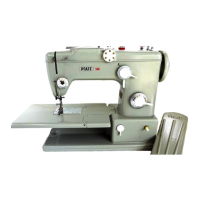Set
stitch length dial G on "0"
and
run the machine. Check
to
see
that the
feed
dog
moves
up
and
down,
but
does
not move bock
and
forth. If
adjustme
nt
is
required,
rotate
the stitch length
regulator
mechanism
to
the right
or
left,
as
appropriate
. Do not
forget
to
tighten the set screw securely which holds the
mechanism
in
place.
Adjustment
of
the stitch length
regulator
mechanism is
greatly
facilitated
by
wrench No. 106300-304 which
can
be
obtained
from Pfaff at
extra
cost.
Ad
justing the Bobbin Winder
Fig.
93
Adjusting
the
bobbin winder
Each
bobbin
winder
is
adjusted
and
tested
at
the factory with utmost
accuracy
in
order
to
ensure
even
bobbin
winding.
If
thread
should pile
up
at
one
end
of
the bobbin, this may
be
an
indication
that
force was
applied
in
removing
or
replacing the
top
cover
. As a result, the
bobbin
winder
frame
may
have
been
bent
out
of
shape
and
t:
he
bobbin wi
nder
spindle
may
be
no
longer
in
o vertical position.
If
thread
piles up
at
the
top
end,
the spindle
has
been
bent
to
the left;
and,
conversely, if
thread
piles
up
at
the bottom
end,
the spindle
has
been
bent
to
the
right.
To remedy this condition,
straighten
the
bobbin
winder
frame.
On
recent ma-
chines,
the
bobbin
winder
frame
has
been
reinforced so
that
it will
not
nor-
mally
be
bent
out
of
shape.
After
this adjustment has
been
performed, the
lateral
position
of
the
bobbin
winder
is
adjusted
in
relation
to
the
balance
wheel.
To
do
this, loosen
set
screw
a
in
the bobbin
wi
n
der
frame
base
(Fig.
93)
and
move
the Iotter
over
to
the
balance
wheel until the
rubber
ring
on
the
winder
pulley just contacts the
inner
surface
of
the
ba
l
ance
wheel
and
is
driven securely
when
the
bobbin
wi
nder
is
engage
d. Excessive
pressure
exerted on the
balance
wheel
by
the
bobbin
winder
pulley will result in heavy working
of
the
machine
and
prema-
ture
wear
of
the
rubber
ring.
57

